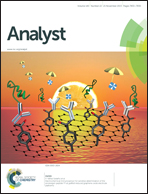Detection of neuraminidase stalk motifs associated with enhanced N1 subtype influenza A virulence via Raman spectroscopy
Abstract
Oligonucleotides corresponding to neuraminidase (NA) stalk motifs that have been associated with enhanced influenza virulence have been identified using surface-enhanced Raman spectroscopy (SERS). 5′-Thiolated ssDNA oligonucleotides were immobilized onto a hexadecyltrimethylammonium bromide (CTAB) coated Au nanoparticles (AuNP). Three synthetic RNA sequences corresponding to specific amino acid deletions in the influenza NA stalk region were attached to the CTAB-modified AuNPs. Two of these sequences were specific to sequences with amino acid deletions associated with increased virulence, and one was a low virulence sequence with no amino acid deletions. Hybridization of synthetic matched and mismatched DNA–RNA complexes were detected based on the intrinsic SERS spectra. In addition, this platform was used to analyze RNA sequences isolated from laboratory grown influenza viruses having the NA stalk motif associated with enhanced virulence, including A/WSN/33/H1N1, A/Anhui/1/2005/H5N, and A/Vietnam/1203/2004/H5N1 strains. Multivariate feature selection methods were employed to determine the specific wavenumbers in the Raman spectra that contributed the most information for class discrimination. A one-way analysis of variance (ANOVA) test identified 884 and 1196 wavenumbers as being highly significant in the high and low virulence spectra, respectively (p < 0.01). A post-hoc Tukey Honestly Significance Difference (HSD) test identified the wavenumbers that played a major role in differentiating the DNA–RNA hybrid classes. An estimate of the spectral variability, based on the Wilcoxon rank sum test, found the major source of variation to be predominately between the different classes, and not within the classes, thus confirming that the spectra reflected real class differences and not sampling artifacts. The multivariate classification methods partial least squares discriminant analysis (PLS-DA) and support vector machine discriminant analysis (SVM-DA) were able to distinguish between different NA stalk-motifs linked to NA-enhanced influenza virus virulence (NA-EIV) with >95% sensitivity and specificity in both synthetic RNA sequences as well as the isolated viral RNA. This study demonstrates the feasibility of SERS for direct identification of influenza NA stalk mutations associated with virulence without sample amplification or labeling.


 Please wait while we load your content...
Please wait while we load your content...